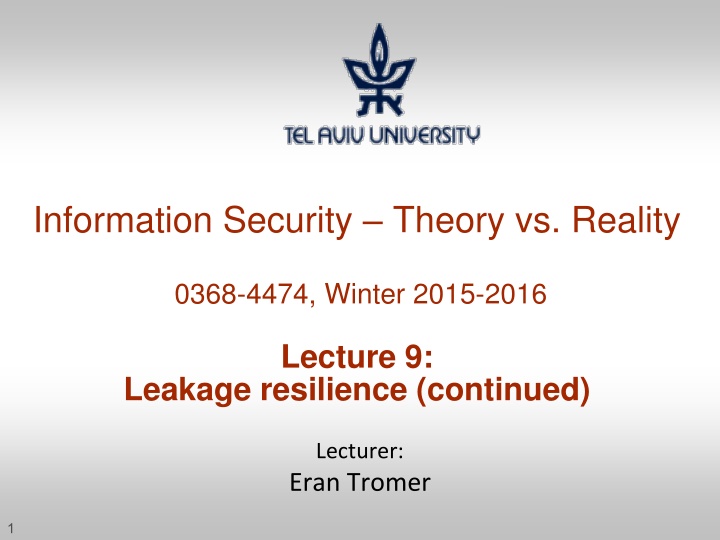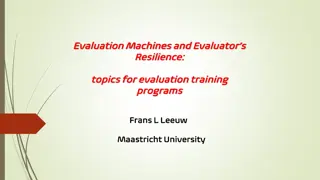
Leakage Resilience and Security Measures in Information Theory
Delve into the lecture on leakage resilience in information security theory versus reality, exploring concepts such as sum-of-wires leakage, dual-rail logic, resilient schemes, and more in the realm of safeguarding against tampering and protecting privacy.
Download Presentation

Please find below an Image/Link to download the presentation.
The content on the website is provided AS IS for your information and personal use only. It may not be sold, licensed, or shared on other websites without obtaining consent from the author. If you encounter any issues during the download, it is possible that the publisher has removed the file from their server.
You are allowed to download the files provided on this website for personal or commercial use, subject to the condition that they are used lawfully. All files are the property of their respective owners.
The content on the website is provided AS IS for your information and personal use only. It may not be sold, licensed, or shared on other websites without obtaining consent from the author.
E N D
Presentation Transcript
Information Security Theory vs. Reality 0368-4474, Winter 2015-2016 Lecture 9: Leakage resilience (continued) Lecturer: Eran Tromer 1
Leakage resilience (continued) 2
Security [Ishai Sahai Wagner 03] ?? ?? ?? ?? ?? ?? ? ? Adversary chooses a leakage/tampering function, from a given set of admissible leakage/tampering functions, to be applied to the wires. admissible leakage/ tampering black box indistinguishable simulator adversary 3
Security definition CIRCUIT CIRCUIT C INPUT OUTPUT C INPUT OUTPUT T s0 s0 MEMORY MEMORY Transformer ? protects privacy (of the initial state) against a given class of admissible leakage/tampering: circuit C efficient Sim admissible Adv initial state s0 : SimAdv,C[s0] output of Adv attacking C [s0 ] (Even in case of tampering, only privacy is required) 4
Resilient-schemes 1/3 (whiteboard discussion) Sum-of-wires leakage Dual-Rail Logic Sum-of-wire-transitions leakage Dual-Rail Precharge Logic 5
Resilient-schemes 2/3 (whiteboard discussion) Single-wire leakage Bit masking or secret sharing Multiple-wire leakage Secret sharing Leakage of data-dependent values from bulk computation RSA blinding 6
t-wire leakage [ISW03] Secrets additively secret-shared into m=2t+1 shares Given shares of a=a1 am and b=b1 bm : Compute shares of NOT(a) : apply NOT to a1 Compute shares ci of a AND b : Let zi,j , i<j, be random independent bits Let zj,i=(zi,j aibj) ajbi (i<j) Let ci=aibi j izi,j Re-randomize s at every iteration (hence m=2t+1). Security proof sketch: simulator runs adversary and, when asked for leakage value: if answer implied by inputs / inputs / previous answer, answers thus. Otherwise answers randomly. This has the correct distribution. s0 7
Other leakage? ' is si x Y X Y C C indistinguishable 8
Our goal Allow stronger leakage. 9
Leakage classes Locality assumptions Single wire, t wires Separate sub-circuits Leak-free processor: Oblivious RAM [Goldreich Ostrovsky 95] Leak-free memory ( only computation leaks information [Micali Reyzin 04]: leakage is only from CPU state and memory accessed at that program step) Quantitatively bounded Total #bits leaked Total #bits leaked per computational step Noisy leakage from every wire Simple leakage Sums and Hamming weights Low-complexity global functions Too-complicated leakage (hard to invert) Some of these are for specific functionality (mainly crypto) Open problem: realistic models allowing secure and efficient constructions. 10
Trusted Computing Architecture (warmup discussion, see next week s slides) 11






















